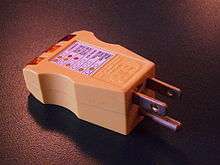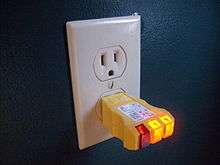Receptacle tester

A receptacle tester or outlet tester is a device used to verify that an AC wall outlet is wired properly. The tester itself is small device containing a power plug and several indicator lights. Although a multimeter could be used to perform a series of tests which would give the same results, an outlet tester can perform the entire array of tests by simply plugging the device into the outlet once and observing the state of the lights. The tester performs several tests at once but the tests themselves essentially fall into two categories: tests which determine that the outlet has power connected, and tests which determine that the outlet is properly wired for safe operation.
Tests performed
Functionality
The most basic job of the outlet tester is to verify that the outlet can provide power to a device plugged into it. In order for an AC outlet to be functional it must have, at a minimum, a live or "hot" connection to a varying electrical voltage, and a neutral connection to complete the circuit. If either of these is not hooked up, or is damaged in some way, then the outlet will not function at all. The voltage between these two connectors also needs to fall within a certain range for proper operation, however many outlet testers only check for the presence of voltage across the proper connectors, not the actual level of voltage, which can easily be checked with a multimeter. [1]
Certain uncommon faults in wiring may give a good indication on a receptacle tester, but the receptacle may still not work for actual appliances. The lamps in the tester require very little current to light and a high-resistance joint or a stray voltage may give false indications on the tester. [1] The lights in the receptacle tester do not indicate that the voltage (or frequency) is correct, only that some voltage is present.
Safety

The more important role of the outlet tester is to check that the outlet is properly wired, with each contact connected to the proper wire in the building's wiring. [1]There are two primary reasons for testing this. First, some devices must have a specific prong connected to the live connection or damage to the device could result. Second, and more importantly, if the live wire is connected but the neutral or ground wire is not, a dangerous situation could be created by preventing safety mechanisms from operating properly. Furthermore, the ground wire is typically attached to the case of an electrical device as a safety precaution to carry away current if the insulation on the wires is damaged and the case becomes charged. Although this is an important safety feature on many devices, if the outlet is improperly wired with the ground plug connected to the live wire the safety mechanism has the opposite effect and charges the outside of the device creating the potential for an electric shock for anyone touching the device.
Simple three light testers cannot detect two potentially serious house wiring errors: (1) neutral and ground reversed at the receptacle. (2) a bootleg ground, where the neutral and ground pins have been connected together at the receptacle. This may be done by someone fitting 3-prong receptacles on a circuit that has no ground wire. These errors can be detected with a multimeter and a test load, to verify that the ground connection is separate from the neutral and is not carrying normal circuit current.
Some receptacle testers include an additional test button to check GFCI devices, which supplements the test button within the GFCI, and can be used for testing outlets downstream from a GFCI receptacle.[1]
See also
References
| Wikimedia Commons has media related to Receptacle testers. |
External links
- Ways a receptacle tester can mislead (by an electrician)
- How to do more accurate testing with voltmeter